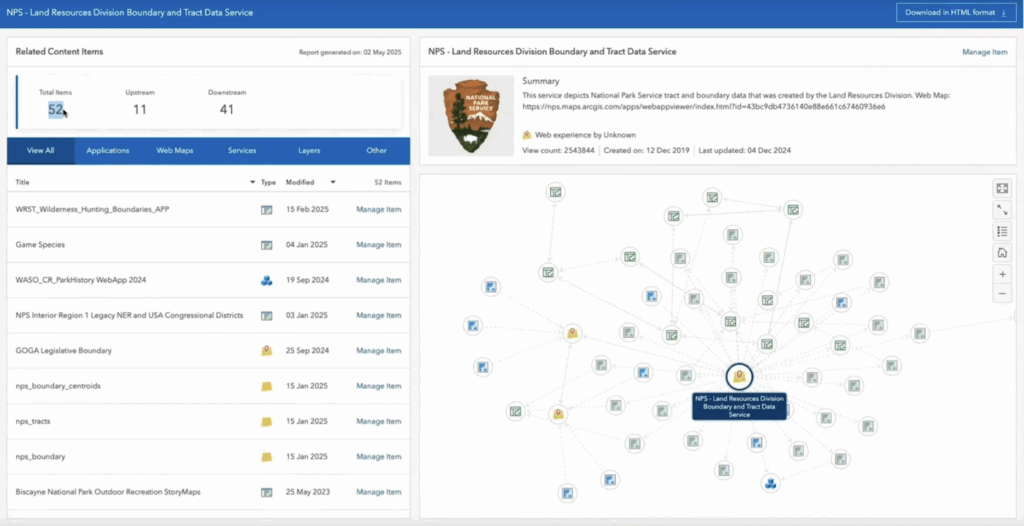Managing large ArcGIS environments can be overwhelming, especially when it comes to discovering, understanding, and maintaining content spread across users, groups, and servers. But what if you could automate all of that without deploying any additional infrastructure?
In our recent webinar, Automating ArcGIS Content Discovery with FME: A Real World Use Case, Kieran O’Donnell from Ripple shared how his team leveraged FME to revolutionize how they interact with their ArcGIS ecosystem. This use case highlights the power of FME for real-time insight, simplified maintenance, and risk reduction.
Navigating complex ArcGIS environments with an FME-powered content discovery dashboard
Enterprise ArcGIS environments often include thousands of datasets, services, and groups, all connected through intricate relationships. Understanding the dependencies and identifying redundant or broken content is a time-consuming manual process prone to error. Ripple, like many organizations, needed a better way to make sense of their ArcGIS environment and ensure healthy, sustainable systems.
Kieran and his team set out to build a solution that could:
- Automatically scan their ArcGIS ecosystem.
- Visualize relationships between content, users, and groups.
- Generate real-time, easily shareable reports.
- Require no external infrastructure outside of FME.
They created a lightweight, web-based dashboard, built with FME and HTML. It uses FME Flow, the ArcGIS REST API, and a combination of automation tools like webhooks and D3.js to provide immediate insights into their ArcGIS environment.
The dashboard enables:
- Content Discovery Automation: Scheduled FME Flow workspaces query the ArcGIS REST API and gather information about all available items, including services, layers, and dependencies.
- Relationship Mapping: Leveraging FME’s data transformation and structuring capabilities, the team created visualizations that expose how content relates to users and groups. The interactive reports help quickly identify ownership and usage patterns.
- On-Demand Reporting: A simple web interface allows users to trigger up-to-date reports at any time. Using webhooks and Flow Apps, stakeholders can click a button to generate a fresh dashboard view without ever touching FME itself.
- Visual Insights with D3.js: The team integrated D3.js into the HTML output to render dynamic visualizations—perfect for communicating complex relationships in a user-friendly way.
- Zero Additional Infrastructure: Since everything is built and hosted within FME, there’s no need for external servers, apps, or services. It’s a scalable, maintainable solution with a low barrier to entry.

Key Technology Used
- FME Flow Projects were instrumental for deploying reusable, scalable workflows and content to their FME Flow environment.
- Webhooks enabled real-time responsiveness, generating content the moment it’s needed.
- HTML & D3 combined with FME’s automation made it possible to deliver a lightweight yet powerful dashboard experience.
Top Takeaways
Automating relationship discovery saves time, reduces manual error, and provides transparency across teams. This case study was a great example of how lightweight dashboards built with FME allow for fast deployment and low maintenance, without costly infrastructure or third-party tools. FME acted as a standalone, no-code solution for managing and analyzing ArcGIS environments.
Kieran’s top lessons:
- If it can be done manually, it can be done automatically. In the spirit of working smarter not harder, always search for ways to automate tasks.
- Data is only valuable if it’s understandable. Even the most detailed data has a limited impact if users can’t make sense of it. Data that’s engaging and understandable is infinitely more valuable.
With the right tools and approach, even complex ArcGIS ecosystems can become manageable, transparent, and efficient. Whether you’re dealing with content sprawl, broken dependencies, or the need for better reporting, it’s easier than ever to build solutions tailored to your organization’s needs.




